Spot-By-Spot, or Route-By-Route? SFMTA Refines Its Bicycle Strategy
5:21 PM PDT on April 19, 2013
The SF Municipal Transportation Agency is pondering the most effective way to improve the city's bicycle network in the coming years as it rolls out its Bicycle Strategy: Should planners focus bicycle improvements on dangerous and stressful spots throughout the city, or focus on upgrading major bike corridors to the highest quality of comfort first?
Tim Papandreou, deputy director of transportation planning for the SFMTA Sustainable Streets Division, posed the question to the SFMTA Board of Directors Policy and Governance Committee today, presenting a color-coded map showing the level of stress posed by traffic conditions at almost any given spot on the city's official bicycle network.
On one end of the spectrum, spots that are comfortable for most anyone aged eight to 80 to ride a bike were colored with a deep blue. On the other, high-stress spots that are "tolerated only by the 'strong and fearless'" were marked with a deep red. Needless to say, the map had lots of red, and very little blue.
The "primary corridors" include popular bicycling streets like Market, Polk, Folsom, San Jose, and the Embarcadero. "That's where the majority of people are already cycling, and that's where the majority of people will increase their cycling as well," said Papandreou.
Committee members Cheryl Brinkman and Joél Ramos said they favored the "primary corridors" option, since it seemed to be the most effective approach toward garnering safety in numbers. That approach "is going to help us get where we need to be, and make people look around and see other people, who just look like your average San Franciscan, riding a bike for pleasure, for transport, for errands," said Brinkman.
SF Bicycle Coalition Executive Director Leah Shahum called on the SFMTA to aim for its most ambitious option in the Bike Strategy -- the "System Build-Out Scenario," which would require an estimated $500 million to implement over five years and increase bicycling to 20 percent of all trips. Currently, the agency has its sights set on the mid-level "Strategic Plan Scenario," which requires $190 million and would only increase bicycling to 8 to 10 percent, according to Papandreou.
"We really hope you won't water that down," said Shahum. "Put the needs out there, and strive to reach it."
SFMTA Director of Transportation Ed Reiskin said the agency is looking for new sources of revenue to fund its bicycling ambitions. As the city updates its 10-year capital plan, "We'll be as aggressive as we can," he said.
Shahum also praised the deep level of analysis taken by SFMTA planners. "We're hearing from a lot of our colleagues in other cities, and at the national level, that they haven't seen any work like this, at this depth with this strategic thoughtfulness," she told SFMTA staff.


Read More:
Stay in touch
Sign up for our free newsletter




